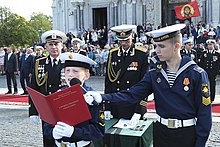Kronstadt Sea Cadet Corps
Кронштадтский морской кадетский корпус | |
 A Kronstadt sea cadet. | |
| Motto | Knowledge, honor and duty! (Знание, честь и долг!) |
|---|---|
| Type | boarding school |
| Established | 1995 (date established) 2015 (reorganized) |
| Affiliation | |
Officer in charge | Reserve Captain 1st Rank Nikolai Dovbeshko[1] |
Academic staff | 63 |
Administrative staff | 67 |
| Students | 560 |
| Location | , Russia 59°59′39″N 29°45′20″E / 59.9941°N 29.7555°E |
| Language | Russian |
The Kronstadt Sea Cadet Corps (Russian: Кронштадтский морской кадетский корпус) is a military boarding school of the Russian Navy.
History
The corps follows the traditions maintained by the original Russian cadet corps in the Imperial Russian Navy.[2] The process of its creation began on 25 April 1995 by order of the Mayor of St. Petersburg Anatoly Sobchak.[3][2] The corps was created at the insistence of President Boris Yeltsin and a joint decision Minister of Defense Pavel Grachev and Mayor Sobchak. On 1 October, the first 75 pupils were enrolled in the corps at Komarovo.[4] On 22 November, First Deputy Commander-in-Chief of the Navy, Admiral Igor Kasatonov presented to the cadet corps its first regimental colours. This day became an official holiday in the school.[5] In early 1996, it was transformed into a naval educational institution. The decree on 19 February of that year established a seven-year training period for the cadet corps. By August of that year, the maximum capacity was determined at 700 pupils. In 2000, the first graduation ceremony took place. On 1 December 2012, Admiral Viktor Chirkov presented new colours to the corps in a presentation ceremony.[6]
General information
Only boys of 10–11 years old who are admitted into the corps.[7] The building has 28 classrooms, 24 classrooms, with the science rooms being featuring with laboratories equipped with modern equipment. From the seventh grade, cadets learn two foreign languages: the English language and the German language.[8] The building has an assembly hall for 200 people, and a reading room for 50 seats. Cadets train on training ships in the city.[9] Upon graduation from the corps, cadets receive a secondary education certificate and a breastplate, having the right to enter higher military academies of the Ministry of Defense of Russia without exams.[2]
Awards
- Cup of the Commander-in-Chief of the Russian Navy
- Diploma of the Commander-in-Chief of the Navy (2013)
- Diploma of the Minister of Defense of Russia (2015)
- Diploma of the Minister of Defense (2015)[5]
References
- ^ Стасовский, Александр Дробышевский, Анатолий. "Николай Довбешко: Обучение в Кронштадтском морском кадетском корпусе ведётся по типу корпусов императорской России". Еженедельник «ЗВЕЗДА».
{{cite web}}: CS1 maint: multiple names: authors list (link) - ^ a b c "Морской кадетский корпус". flot.com.
- ^ "Распоряжение Президента РФ № 155-рп от 3.04.1995". www.ruscadet.ru.
- ^ "Морской кадетский корпус в Кронштадте. Школа мужества".
- ^ a b "Историческая справка". kmkk.mil.ru.
- ^ "Кронштадтский морской кадетский военный корпус : Министерство обороны Российской Федерации". Archived from the original on 2020-07-23. Retrieved 2020-07-23.
- ^ "Кронштадтский морской кадетский корпус". www.kronkadet.ru.
- ^ "КМКК, Кронштадтский морской кадетский корпус — Учёба.ру". spb.ucheba.ru.
- ^ "Over 1,000 cadets to practice maritime skills onboard two Russian Navy training ships in 2018".
